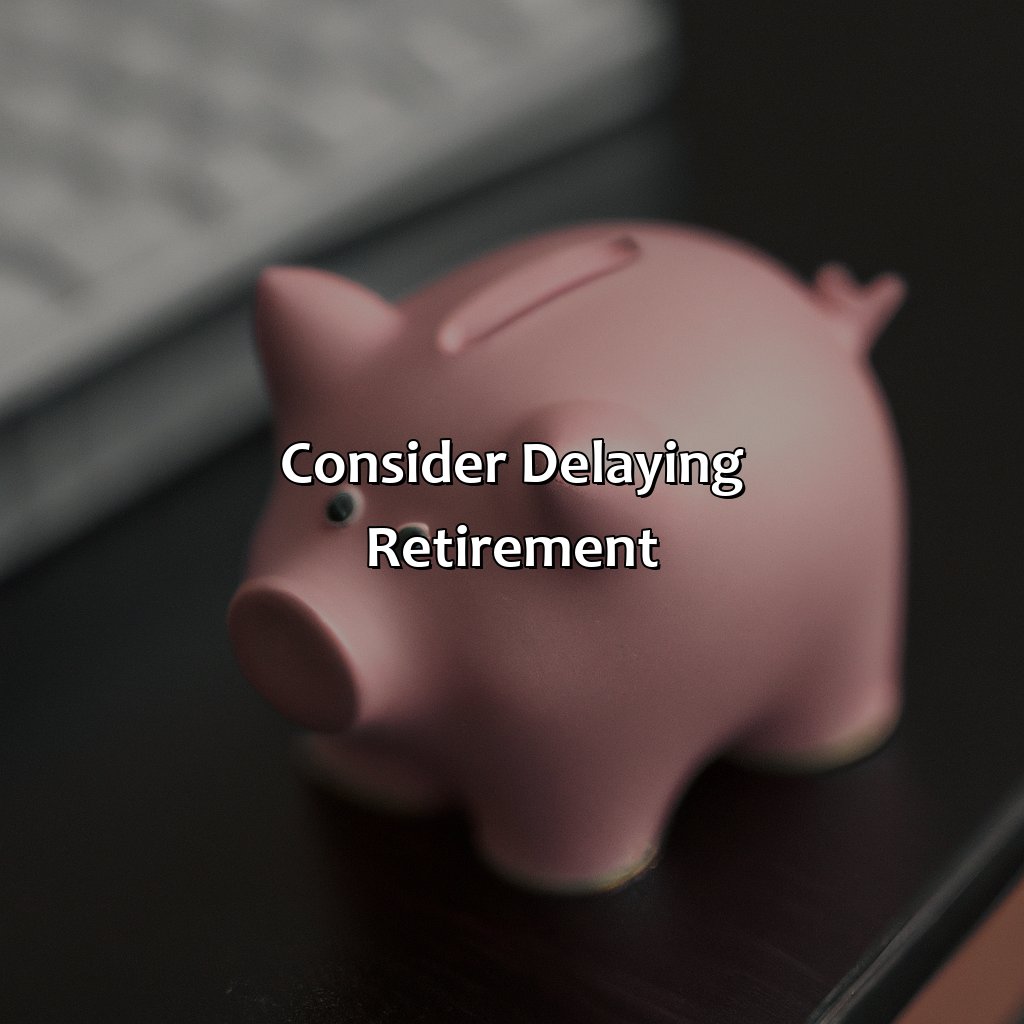How To Catch Up On Retirement Savings?
Key Takeaway:
- Assess your current retirement savings: Before making any changes, it’s important to take stock of your current situation, including your retirement saving goals, current balance, and expected income. This will help you identify any gaps and determine how much you need to save.
- Increase your contributions: The easiest way to catch up on retirement savings is to increase your contributions. This might mean contributing more to your 401(k) or IRA, or finding additional income streams to put towards retirement. Automation can help keep you on track and make it easier to consistently save.
- Adjust your investment strategy: A financial advisor can help you determine the right investment strategy for your goals, risk tolerance, and timeline. Diversifying your portfolio can also help manage risk and increase potential returns.
Do you feel like you’ve been left behind in the retirement savings race? Don’t worry, you can catch up. In this article, you’ll find out the essential tips and strategies to help you get back on track.
Assess Your Current Retirement Savings
It is crucial to evaluate your present retirement savings, determining how much you have saved, and how much you need to save to secure your future. Assessing Your Retirement Plan is the most significant step towards a comfortable retirement. You must plan and track the progress regularly to achieve your financial goals.
One of the critical steps towards catching up on retirement savings is to determine how much you have saved so far. Understanding whether you are on the right path towards your retirement goals or not is vital. You can seek assistance from the retirement planning calculator or retirement planning professional to assess the savings or investment strategy.
It would be best if you considered several factors like inflation, your life expectancy, income needs, etc., while assessing your current retirement savings. There are multiple online tools available that can assist you in determining the retirement savings required to meet your financial goals. These tools help you map out how much to save every month and how much to put into your retirement account.
Catching up on your retirement savings is not a new trend; there are several successful stories of people who did it already. Kimberly Palmer, author of “The Economy of You,” has shared her story in which she started doubling her retirement contribution in her late 30s, allowing her to save over six times her annual salary by age 40.

Image credits: retiregenz.com by Adam Jones
Increase Your Contributions
Upping your retirement savings? Increase your contributions! Here, let’s look at two easy ways to do it:
- Take Advantage of Catch-Up Contributions
- Automate Your Savings
Boom!

Image credits: retiregenz.com by Joel Woodhock
Take Advantage of Catch-Up Contributions
To maximize your retirement savings, Take Advantage of Catch-Up Contributions. Here are three points that can be beneficial:
- If you’re 50 or older, you can contribute up to an additional $6,500 to your 401(k) plan in a given year.
- You can make catch-up contributions to an IRA as well; it’s an extra $1,000 annually.
- Check with your employer regarding their specific catch-up contribution policies.
It’s never too late to increase your retirement savings and safeguard your financial future! Inquire about taking advantage of catch-up contributions now.
One individual who didn’t start saving for retirement until their mid-forties used catch-up contributions and ultimately achieved a comfortable retirement.
Let robots handle your retirement funds, because sometimes they’re better at adulting than we are.
Automate Your Savings
To Maximize Your Retirement Savings
Automating your savings can increase your retirement funds. Follow these easy steps:
- Prioritize: Decide on a percentage of your income to save each month. Calculate all expenses and retirement goals before setting an amount.
- Set Up Automated Transfers: Directly send the decided amount into a separate high-yield savings account automatically every month through payroll deduction or electronic transfer.
- Monitor Regularly: Review the automated transfer settings and account balance regularly to ensure that you reach your goals effectively.
It is essential to keep in mind that automation does not allow flexibility in altering contributions if necessary. Therefore, consult with a financial advisor for substantial investment options and changes rather than solely relying on automated savings.
According to Forbes, “Nearly half of Americans feel they are saving too little.”
“Retirement will be delayed until I’m finally able to achieve my lifelong dream of becoming a professional beach bum.”
Consider Delaying Retirement
Considering retirement delay when you’re having difficulty with retirement savings is smart. Two sections that may aid in this are ‘Work Longer’ and ‘Part-Time Work’.

Image credits: retiregenz.com by Joel Arnold
Work Longer
Extending Your Career
One efficient road to increase retirement savings is by working for a longer duration. Retiring at the usual age of 65 typically provides more than three decades of non-working life, and many individuals have become reliant on this extended period. However, prolonged life expectancies mean that people should continue earning money for longer.
Postponing your retirement and remaining employed boosts your savings portfolio, enhances Social Security benefits, and reduces reliance on financial investments for income generation. Those who can delay their retirement may reap higher returns in the long term because they would have less time to draw down from their portfolios or initiate pension payments.
In addition to extending work-life, other ways to build up your post-working years’ funds include reinvesting returns from bonds and stocks over time or depositing into tax-advantaged accounts such as Roth IRA’s or 401(k) schemes. If you lack proper expertise or experience in investing or saving earlier in life, being mindful of those strategies early enough could create greater advantages when you get into midlife.
To ensure that one has adequate finances in retirement years, experts recommend assessing the cost of living and creating a budget plan focusing on income prospects and envisioned expenditures well ahead of time. Consider reaching out to a retirement planning advisor if you feel uncertain about making important economic choices.
By postponing retirements due date individuals can increase their savant level significantly. Maximizing returns after various saving mediums expansion, including bonds & stocks investment or using tax-preferred systems such as Roth IRA or 401(k). Research your retiring destination social safety then draft plans quickly one misstep will cost unnecessary funds later.
Picking up a part-time job in retirement is like adding a lemon slice to your already watered-down glass of retirement savings.
Part-Time Work
Working Part-Time can be an effective solution for those behind on retirement savings. By reducing work hours, individuals can earn additional income while still saving time for other activities. This allows seniors to have more flexibility in their retirement years and enjoy a better quality of life.
Part-Time Work offers several benefits, including:
- Supplementing retirement income
- Staying busy with meaningful activities
- Improving mental health by staying active.
- Part-time work can also provide social connections and new experiences through meeting new people or trying new things.
For those considering Part-Time Work, it is important to find the right balance between earning income and enjoying leisure time. It is essential to choose a job that aligns with personal interests or passions to make work feel enjoyable instead of like a chore.
In one case study, Jennifer retired at 62 but realized she hadn’t saved enough for her dream retirement lifestyle. She decided to take up part-time work at a local bookstore and discovered a newfound passion for literature while earning additional income. She now enjoys an active social life and is debt-free with plenty of savings for her future years.
Who needs a crystal ball when you can just adjust your investment strategy and make your retirement dreams a reality?
Adjust Your Investment Strategy
To spruce up your retirement savings, consult with a financial advisor! Diversifying your portfolio is another great step to take. It’ll give you a deeper understanding of the financial market and open up a plethora of investment options.

Image credits: retiregenz.com by David Woodhock
Consult with a Financial Advisor
Seeking expert advice from a financial planner can help devise a personalized retirement plan that matches individual risk tolerance and future income needs. Gain insights on effective investment decisions, smarter tax strategies to maximize savings, and potential pitfalls to avoid.
A qualified financial advisor can understand the investor’s current situation, identify any gaps in their retirement plan and suggest actionable steps towards meeting retirement goals. Planning for long-term care expenses and diversification of assets are crucial factors to consider while charting the path to retirement readiness.
Empower wealth-building with early start planning, periodic reviews, and adjustments in investment strategy. Pro Tip: Find an Advisor who operates on a fiduciary standard, puts your best interest first rather than making commission-based recommendations.
Putting all your eggs in one stock is like going all-in with a pair of twos – diversify or risk losing your retirement savings.
Diversify Your Portfolio
To increase your investment benefits, balance and distribute your funds across various types of accounts. Utilize a literal meaning of the common phrase, “Diversify Your Portfolio.” By creating an assortment of stocks, bonds, real estates, and mutual funds in different areas and sectors, you minimize risk.
Furthermore, spreading out your assets also maximizes potential earnings. An authoritative source suggests that a diversified portfolio performs significantly better than a single asset approach. A well-diversified investment plan will reduce fluctuations in individual company or market performance, leading to a more reliable and lucrative retirement fund.
Intelligently allocating funds to conventional accounts such as Roth IRA plans and 401(k)s is not adequate for some particular cases. Exploit other financial instruments like interest-bearing savings accounts or CDs for the longer-term investments. Experienced investors can consider more complex investment choices like options trading or real estate investment trusts.
Once John retired, he met with his financial advisor to discuss his retirement funds’ balance. Following their conversation highlighting decreased future social security incomes and increased healthcare costs ahead of him, it was evident that John fell behind on his savings strategy. He quickly diversified his portfolio by including alternative bonds and international stocks that previously were not included in his portfolio so that he would not lose money with one disastrous investment outcome again.
Why sacrifice your morning coffee when you can just sacrifice your retirement plans instead?
Cut Down on Expenses
Reduce expenses and save for retirement. Prioritize spending and pay off high-interest debt. These sections will help you allocate money better for retirement without sacrificing your financial needs.

Image credits: retiregenz.com by James Arnold
Prioritize Your Spending
To optimize savings, it’s imperative to ‘Allocate Your Spending‘. Here’s how:
- First, reduce non-essential purchases.
- Second, prepare a budget and track spending regularly
- Third, switch to more affordable options and save big on daily expenses.
- Fourth, prioritize essential expenses like healthcare and insurance premiums.
- Fifth, seek professional help for managing financial investments.
While controlling everyday expenses is good practice; one should also keep an eye on long-term goals. Give preference to savings instruments that are low-risk but offer higher return in the long run.
To grow your retirement fund and ensure financial independence post-retirement; get into action right away by cutting down unnecessary spending and redirecting those funds towards retirement savings!
Saying goodbye to high-interest debt is like ending a toxic relationship: painful at first, but ultimately liberating.
Pay Off High-Interest Debt
Eliminating debts with high interest rates is a crucial step in securing your retirement savings. These debts, which normally comprise credit card balances or payday loans, may accrue double-digit interest rates that take a considerable bite out of your income and savings. By eliminating these debts, you will reduce your expenses and free up resources for investment in retirement plans.
Furthermore, with the help of debt reduction strategies like budgeting and consolidation, you can simplify your payment process and lower the total amount owed. This minimizes the drag on your wealth accumulation over time, allowing you to accumulate more cash relative to what would have been paid in interest.
Reducing high-interest debt is particularly significant for individuals who are only commencing their retirement plan or are unable to save as much as they should. Eliminating those persistent debts will decrease stress long-term, making it simpler to save efficiently for strong post-retirement finance.
According to a recent survey by US News & World Report, approximately two-thirds of Americans who are at least 50 years old owe non-mortgage debts averaging $17,623. Focusing on reducing those financial strains will result in a more tranquil retirement journey.
Retirement income plan: Hope for the best, but don’t forget to plan for your adult children moving back in.
Plan Your Retirement Income
How to Catch Up on Retirement Savings?
Plan your retirement income! Utilize retirement accounts. Also, think of additional income streams. These two sub-sections can help you optimize your retirement income and catch up on savings.

Image credits: retiregenz.com by Harry Arnold
Utilize Retirement Accounts
Retirement accounts are effective sources of retirement income. Here’s how to make the most of them:
- Contribute as much as you can afford to your 401(k) or equivalent.
- If you’re over 50, consider catch-up contributions to help increase retirement savings.
- Maximize contributions to traditional and Roth IRAs, depending on which one suits your needs better.
- Roll over old retirement account balances into new ones to avoid penalties and consolidate your investments.
By using these strategies, you can make a significant impact on your retirement savings. It’s essential not to rely solely on Social Security benefits since they may not be enough. Instead, develop multiple sources of retirement income to help ensure a comfortable retirement.
Historically, many workers did not plan for their future, relying instead on pensions that didn’t materialize as promised. However, taking control of your savings today can put you in a much better position when it comes time for retirement.
Retirement income streams: because even the most frugal cat lady can’t survive on ramen noodles alone.
Consider Additional Income Streams
Expanding your revenue can be an excellent way to make up for lost time in your retirement savings. Here are three ways you can consider additional income streams:
- Investing in stocks and bonds
- Developing a rental property
- Working part-time or freelancing
Expanding passive or semi-passive income streams on top of your existing retirement alternatives could help you catch up on retirement savings. Recognize opportunities that align with your skills and capabilities, but also bring enjoyment, as it could benefit both retirement accounts and personal well-being.
According to a study by the Employee Benefit Research Institute, approximately 80% of retirees rely on Social Security benefits as their primary source of income.
Stay Committed and Motivated Towards Your Retirement Goals
Achieving your retirement goals requires a commitment and consistency, even when it seems difficult. Keep yourself motivated by focusing on the ultimate goal of financial freedom and independence. It’s important to establish a realistic savings plan that suits your lifestyle. Start small and gradually increase the amount you save each month. Be mindful of your expenses and make adjustments when necessary.
When you stay committed and motivated towards your retirement goals, you are more likely to achieve them. Set reminders for yourself, track your progress and celebrate your milestones. Surround yourself with supportive individuals who share similar goals. Visualize your future and the life you want to live in retirement.
To stay on track, consistently review and evaluate your retirement plan. Adjust your plan to match any changes in your financial situation or life circumstances. Focus on long-term success and avoid impulsive decisions.
Pro Tip: Consider seeking guidance from a financial professional to assist you in creating a savings plan that meets your individual needs and goals.

Image credits: retiregenz.com by Harry Washington
Five Facts About How To Catch Up On Retirement Savings:
- ✅ Americans between ages 55 and 64 have an average retirement savings of $104,000, which may not be enough to support a comfortable retirement. (Source: Investopedia)
- ✅ It’s recommended to save at least 15% of your income for retirement, but only 40% of Americans are currently doing so. (Source: CNBC)
- ✅ Catch-up contributions allow those over the age of 50 to contribute more to their retirement accounts, including an additional $6,500 to a 401(k) and an additional $1,000 to an IRA. (Source: IRS)
- ✅ Working longer or part-time during retirement can also help boost retirement savings. (Source: The Balance)
- ✅ Seeking advice from a financial advisor can be helpful in creating a plan to catch up on retirement savings. (Source: Forbes)
FAQs about How To Catch Up On Retirement Savings?
What is catching up on retirement savings?
Catching up on retirement savings refers to increasing your retirement savings rate to make up for any shortfalls or gaps in your retirement nest egg. This is crucial for individuals who may have started planning for retirement late in life or faced unforeseen financial setbacks that hindered their ability to save for retirement.
How can I catch up on retirement savings?
You can catch up on retirement savings by contributing the maximum amount allowed to retirement accounts such as 401(k)s, IRAs, and Roth IRAs. If you are over 50, you are eligible for catch-up contributions, which allow you to make additional contributions to these accounts. In addition, you can also reduce your expenses and increase your income to free up more money for savings.
What are catch-up contributions?
Catch-up contributions are additional contributions that individuals over the age of 50 can make to their retirement accounts above and beyond the regular contribution limit. For example, in 2021, the regular contribution limit for 401(k) accounts is $19,500, while the catch-up contribution limit is an additional $6,500 for those over 50.
What are some tips for catching up on retirement savings?
Some tips for catching up on retirement savings include creating a budget and cutting unnecessary expenses, increasing your income by working part-time or starting a side business, delaying retirement, investing in low-cost index funds, and seeking the advice of a financial advisor.
Is it too late to catch up on retirement savings?
No, it is not too late to catch up on retirement savings. While starting early is always recommended, there are options available for individuals who have not saved as much as they would like for retirement. By making changes to your saving habits and investments, you can increase your savings and improve your retirement outlook.
How can I get help catching up on retirement savings?
You can get help catching up on retirement savings by working with a financial advisor who specializes in retirement planning. They can provide personalized advice and guidance to help you maximize your savings and prepare for retirement. In addition, many financial institutions and online resources offer retirement planning tools and resources to help you get started.






